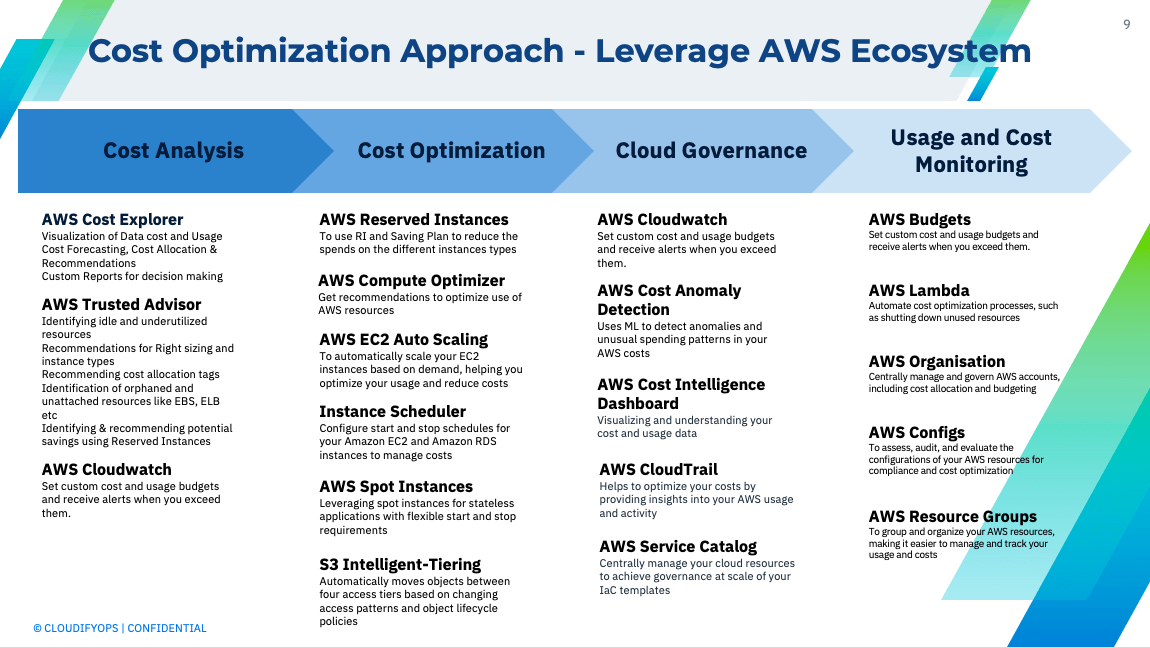Looking to optimize your AWS costs? In this blog, we’ll share the best practices for AWS cost optimization, including tips and strategies for achieving optimal cost savings and improving your efficiency.

As a CTO, I’ve often witnessed startups and companies easily lose sight of their infrastructure costs. With the growing complexity of cloud services and the increasing number of resources needed to support a growing business, managing expenses can become a daunting task. And that’s how “FinOps” was born.
Based on my experience with customers who reach out to us for Cost Optimization, there seems to be a common pattern with why the costs went higher:
- Misconfigured resources
- Over configured resources
- Inefficient Solution Architecture
- Failure to optimize storage and data transfer costs
- Bursty or unpredictable workloads
Whether you’re a new AWS user or an experienced one, our insights and recommendations provided below will help you reduce your cloud expenses while leveraging the best features on the cloud.
By harnessing the power of the AWS ecosystem and its native tools, businesses can achieve significant cost savings while maintaining performance and scalability.
Why do we recommend AWS tools?

What tools do we use at CloudifyOps for AWS Cost Optimization?

Here is the list of recommendations for cost optimization on AWS:
1. Monitor and Analyze Your Costs:
AWS provides powerful cost monitoring and analysis tools such as AWS Cost Explorer and AWS Cost and Usage Reports. These tools allow you to gain insights into your AWS spending patterns, identify cost trends, and visualize cost breakdowns by service or resource. By regularly monitoring and analyzing your costs, you can proactively identify areas where optimization is needed.
2. Right-Sizing Your Resources:
Right-sizing your resources is a fundamental aspect of cost optimization. Analyze your resource utilization and choose appropriately sized instances for your workloads. AWS offers tools like AWS Trusted Advisor and AWS Compute Optimizer that provide recommendations on instance types and sizes based on utilization patterns. By rightsizing your resources, you can eliminate waste and achieve cost efficiency.
3. Auto Scaling:
Leverage Auto Scaling to automatically adjust the number of EC2 instances based on demand. By dynamically scaling your resources up or down, you can ensure optimal utilization while avoiding over-provisioning. This not only helps in cost optimization but also improves the performance and availability of your applications.
4. Reserved Instances (RIs):
Reserved Instances enable you to commit to a certain capacity for a specified duration, resulting in significant cost savings compared to On-Demand instances. Analyze your workload’s usage patterns and consider purchasing RIs for instances with predictable usage. AWS offers various RI types, including Standard RIs, Convertible RIs, and Scheduled RIs, each suited for different scenarios.
5. Spot Instances:
Spot Instances allow you to bid on spare EC2 capacity, offering steep discounts compared to On-Demand instances. They are ideal for fault-tolerant and flexible workloads that can handle interruptions. Spot Instances can deliver cost savings of up to 90%, but it’s essential to architect your applications to handle potential interruptions gracefully.
6. Storage Optimization:
Optimizing storage costs is critical as data volumes continue to grow. AWS provides multiple storage options with different performance characteristics and cost structures. Analyze your data access patterns and choose the appropriate storage class. For example, use Amazon S3 Intelligent-Tiering to automatically move data between storage tiers based on usage frequency, or leverage Amazon EBS Snapshots for cost-effective backups.
7. Serverless Architecture:
Serverless computing, offered by AWS Lambda, allows you to execute code without provisioning or managing servers. By adopting a serverless architecture, you pay only for the actual compute resources consumed on a per-execution basis. This eliminates the need for idle resource provisioning, resulting in significant cost savings and improved scalability.
8. Lifecycle Policies:
Implement lifecycle policies for Amazon S3 to automatically transition objects to lower-cost storage tiers or expire them after a specific time. This approach helps optimize storage costs for data with varying access patterns. By utilizing lifecycle policies, you can ensure that data is stored cost-effectively without sacrificing accessibility.
9. Cost Allocation and Tagging:
Implement a comprehensive tagging strategy for your resources and leverage AWS Cost Allocation Tags. Tags allow you to categorize and track costs by projects, departments, or any other relevant dimensions. With accurate cost allocation, you can gain insights into cost distribution and make informed decisions regarding resource optimization.
10. Trusted Advisor and Well-Architected Framework:
AWS Trusted Advisor is a valuable tool that provides real-time guidance to help optimize costs, improve performance, enhance security, and ensure high availability. Additionally, following the AWS Well-Architected Framework ensures that your architecture aligns with best practices and helps identify potential cost optimization opportunities.
11. Cost-Aware Architecture Design:
Consider cost optimization as a crucial factor during the architecture design process. Utilize tools such as AWS Cost Explorer, AWS Pricing Calculator, and AWS Budgets to estimate costs and make informed decisions about your infrastructure design. By incorporating cost awareness into your design process, you can proactively optimize costs and avoid expensive architectural changes in the future.
Optimizing costs on AWS is an ongoing process that requires proactive monitoring, analysis, and the use of native tools and services provided by AWS. By harnessing the power of the AWS ecosystem, businesses can effectively manage and optimize their cloud spending while maintaining performance and scalability. By continuously refining and optimizing your cost optimization approach, you can unlock the full potential of AWS while maximizing cost efficiency.
CloudifyOps can help you take charge of your cloud costs by identifying the most effective AWS tools and services suited to your cost optimization issues. We have promoted cost awareness across our clients’ organizations instead of being an isolated task managed by a select team of people. We have enabled our client teams to effectively manage and monitor costs with unified cost and observability data. Visit our website for our success stories.
Do you need help with Cost Optimization? Please reach out to us at sales@cloudifyops.com.
P.S.: Honest confession! This blog was partly written using ChatGPT 🙂








